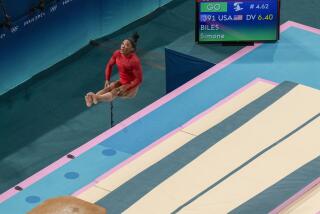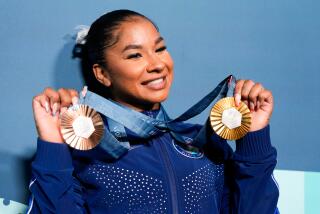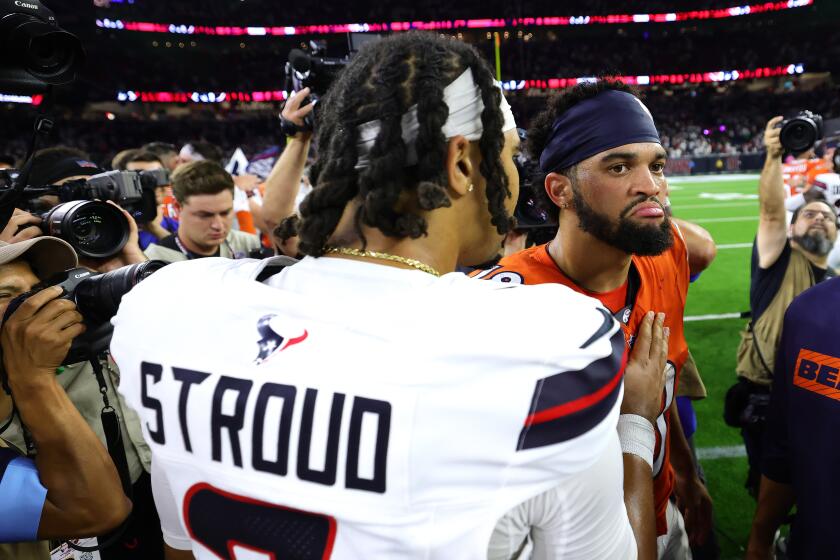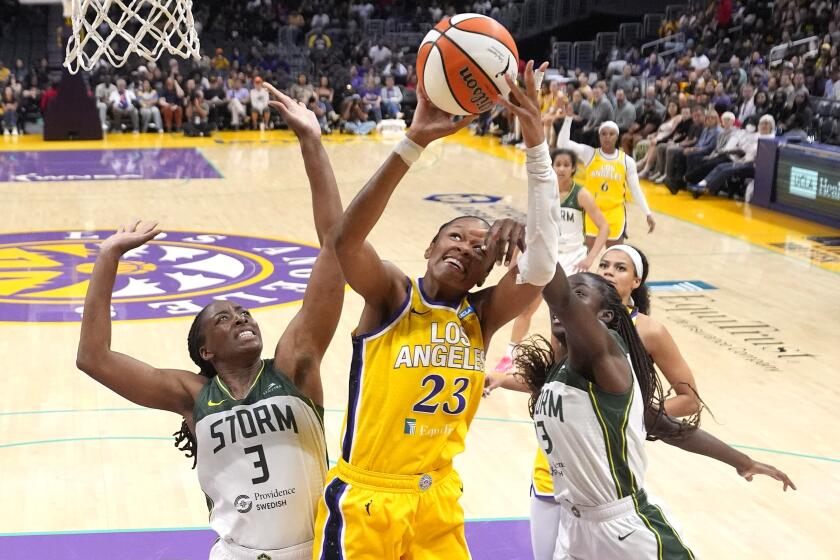No diva, Kim Rhode eyes fifth Olympic shooting medal
Ah, the glamour of being an Olympic medalist.
It is an overcast Wednesday morning in Newhall. The parking lot at the Oak Tree Gun Club is already filling up and the greatest competitive female gunslinger in the history of the good ol’ USA is being put through the paces by a photographer.
Our modern-day Annie Oakley stands on a square of dirt, next to a field of gravel and facing a scraggly hill. A sign warns of rattlesnakes in the area, and Kim Rhode laughs and says, “Almost sat on one here.”
Rhode is an Olympic hero without pretense. Her sport, as well as her personality, makes it so.
Jim Mitchell, owner of the Oak Tree Gun Club, who created this special training area at his club just for Rhode and at considerable cost, says, “If she were in any other sport, she’d be driving a Porsche.”
What does she drive?
Rhode laughs again and says, “A pickup truck, with a hole in the seat.”
Olympic shooting is about as high-profile as Nerf ball. You giggle at the thought of NBC agonizing over how to get more of it on prime time. But this summer, even a track star or gymnast may lose airtime to Rhode. Her story is too good to ignore.
When she starts pulling the trigger in the women’s skeet competition in the London Games, she will be 33 and will have an excellent chance to become the first U.S. athlete to win a medal in an individual sport in five consecutive Olympics. Five medals in five Olympics would be worth noting, even if she were competing in wallpaper-hanging.
In fact, on an American team certain to be full of big names and star quality, Rhode will probably be high on the list of candidates to carry her country’s flag into the stadium during the opening ceremony.
Her prominence began at Atlanta in 1996, when the high school student from El Monte beat an international field in double-trap competition for the gold. She had turned 17 just days before.
She followed that with a bronze in Sydney, another gold in Athens and then, even after the Olympics discontinued her double-trap specialty, she retooled and won a silver in Beijing in 2008 in skeet shooting. Skeet will be her most competitive category again in London, and she also has an opportunity in singles trap, something she qualified for a few months ago after getting a new target machine at Oak Tree and practicing for a week.
The difference between trap and skeet can be oversimplified thusly: Trap targets emerge from ground bunkers at different stations in a semicircle. In doubles trap, the release time and angle vary and both targets must be hit. In skeet, the targets are released from facing ground-level and upper-level stations and head in different directions. Again, both must be hit. The targets move at 65 mph. Do not try this at home.
Missing more than four or five in international competition usually makes you an also-ran. In a March 25 skeet World Cup event at Tucson, Rhode hit 75 of 75 in the three qualifying rounds, a world record. Then she hit 99 of 100 in the final, tying another world record.
Since trap-shooting little leagues would not have a great chance of success in our anti-gun society, Rhode started as most young gun enthusiasts do. It was a family thing. Her father, Richard, a marine biologist, and her mother, Sharon, an administrator at Texaco and later Shell Oil, both hunted and did target shooting. Tagging along was only-child Kim.
On Richard’s bucket list was a hunting trip to Africa. Kim was 10 and went along. The guides took one look at her and said she was too young to hunt. Richard set up a target, handed her a gun and she put three bullets through the bull’s-eye. The guides said she could come along.
Richard still carries faded pictures in his wallet of his 10-year-old daughter, posing proudly with one of her kills, a spiral-horned kudu about twice her size.
“I shot four others,” Rhode says, quickly rattling off the species of her other victims.
By the time she was 13, she was a world skeet champion. When the Atlanta Games brought gold, there was no turning back, nor was there ever a thought of it. Along the way, she has injured her right shoulder so badly in a snowboarding accident that doctors said her shooting career was over. That was 15 years ago. She has also had her $20,000 customized gun stolen by a thief who broke the window of her truck — it was eventually recovered. And recently, she discovered her breast had a lump, which was removed. It was benign, but it cost her about a month of serious training.
There was a slight silver lining in that month’s sabbatical. At least she saved some money.
Richard Rhode estimates that her training costs — shooting between 600 and 1,000 rounds — run about $500 a day. That is ammunition, targets and travel costs to the three places with equipment proper enough for her to train — Oak Tree, Redlands and Prado Dam. She has been training at this pace for 20 years, he says, and if that is 365 days a year times 20 years, simple math brings this bottom line: $3.65 million.
Since her Olympic success, some of that is defrayed by USA Shooting and the U.S. Olympic Committee, as well as sponsors such as Winchester and Perazzi guns, Nike and Otis Technology. But $500 a day is a tough target, and suffice to say, none of her endorsement deals are Michael Jordan shoe contracts.
“She is out, all the time, making speeches and presentations,” Richard says. “In a normal week, two of the appearances will be for charities and the third will be for a sponsor. And then, when she is finished with all that and her training, she goes home and washes the dishes.”
Her husband, Mike Harryman, plays in a band called Fishing for Neptune and works in heating and air conditioning. Home is in Monrovia.
“Not up the hill, in one of those big homes,” Rhode says.
She returned April 22 from a World Cup event in London. This week, she is in Italy for another World Cup. The flights are tough — “squeezed into the back of a plane,” she says — but her commitment is unwavering, so much so that she says, unequivocally, that 2012 will not be her final Olympics.
On this gray morning in Newhall, the photographer kept trying different angles. It went on for half an hour, then 45 minutes. He even squatted directly below her gun as she fired away, assuring him that he was in no danger, as long as he didn’t stand up. As the shooting of the shooting went on and on, thoughts of his forgetting the warning had to be pushed aside.
Later, another thought prevailed.
In well over an hour of constant shooting, Kim Rhode hadn’t missed once.
More to Read
Go beyond the scoreboard
Get the latest on L.A.'s teams in the daily Sports Report newsletter.
You may occasionally receive promotional content from the Los Angeles Times.











